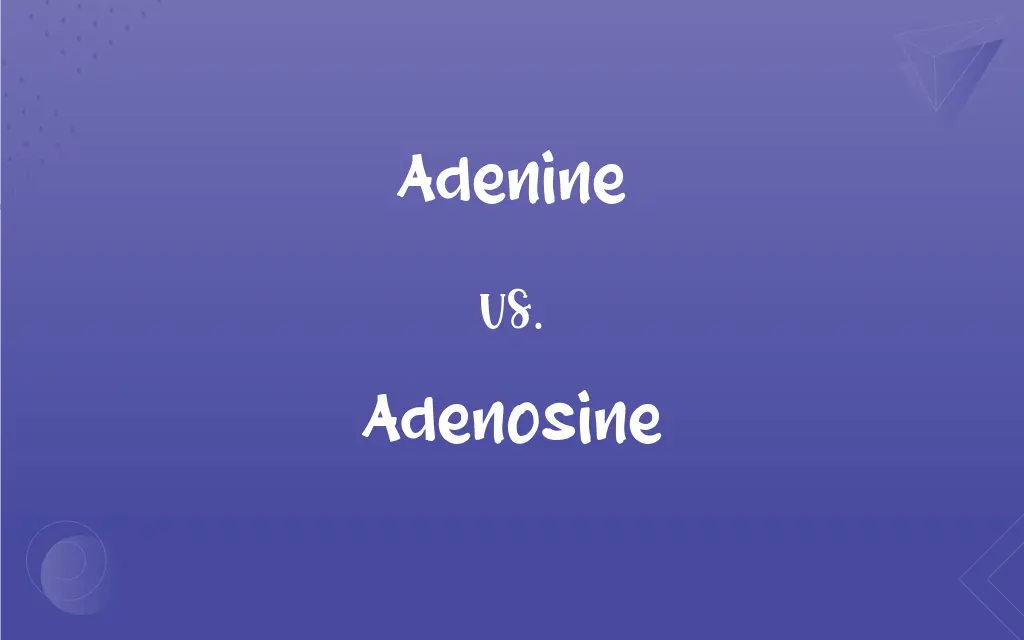Adenine vs. Adenosine: What's the Difference?
By Janet White || Published on December 3, 2023
Adenine is a nitrogenous base in DNA and RNA, while adenosine is a molecule composed of adenine attached to a ribose sugar.

Key Differences
Adenine is one of the four nucleobases in DNA and RNA, playing a crucial role in forming the genetic code. Adenosine, on the other hand, is a nucleoside consisting of adenine and a ribose sugar, serving as a building block for nucleic acids and a participant in energy transfer.
In DNA and RNA, adenine pairs with thymine and uracil, respectively, ensuring accurate genetic information transfer. Adenosine functions beyond genetics, involved in cellular energy processes as part of ATP (adenosine triphosphate) and signaling pathways as a neurotransmitter.
Adenine is a purine base, characterized by its double-ring structure, essential in nucleic acid structure and function. Adenosine impacts physiological processes, including heart rate and blood flow, as it integrates into adenosine receptors in various tissues.
The presence of adenine is critical for the integrity of the genetic code, ensuring the proper sequencing of DNA and RNA. Adenosine's role extends to metabolic regulation, with its presence in coenzymes like NADH and FADH2, crucial in cellular respiration.
Adenine’s role is primarily structural within DNA and RNA, whereas adenosine’s function is more dynamic, influencing numerous biochemical pathways, including energy metabolism and signal transduction.
ADVERTISEMENT
Comparison Chart
Basic Definition
A nitrogenous base in DNA and RNA.
A nucleoside comprising adenine and a ribose sugar.
Role in Genetics
Forms part of the genetic code, pairing with thymine or uracil.
Does not directly participate in genetic coding.
Molecular Structure
Single nitrogenous base.
Adenine base attached to a ribose sugar.
Biological Function
Essential for DNA/RNA structure and genetic information transfer.
Involved in energy transfer (ATP) and signaling.
Presence in Nucleic Acids
Integral component of DNA and RNA.
Forms part of RNA; not a direct component of DNA.
ADVERTISEMENT
Adenine and Adenosine Definitions
Adenine
Adenine is a nitrogenous base found in DNA and RNA.
In DNA, adenine pairs with thymine.
Adenosine
Adenosine is a nucleoside composed of adenine and ribose.
Adenosine plays a key role in forming adenosine triphosphate (ATP).
Adenine
Adenine is one of the purine bases essential for nucleic acid formation.
Adenine's structure is crucial for the stability of the DNA double helix.
Adenosine
Adenosine is involved in cardiovascular regulation.
Adenosine causes vasodilation, increasing blood flow.
Adenine
Adenine is crucial in cellular signaling and metabolic processes.
The role of adenine extends beyond genetics to metabolic regulation.
Adenosine
Adenosine acts as a neurotransmitter in the central nervous system.
Adenosine can induce sleep by slowing down neuronal activity.
Adenine
Adenine is involved in cellular energy processes as part of ATP.
Cellular respiration produces ATP, which contains adenine.
Adenosine
Adenosine functions in signal transduction and energy transfer.
Adenosine binds to its receptors, influencing heart rate.
Adenine
Adenine acts as a fundamental unit in genetic coding.
The sequence of adenine in a gene determines specific protein synthesis.
Adenosine
Adenosine participates in cellular energy processes as part of ATP.
ATP, containing adenosine, is the primary energy carrier in cells.
Adenine
A purine base, C5H5N5, that is the constituent involved in base pairing with thymine in DNA and with uracil in RNA.
Adenosine
A nucleoside, C10H13N5O4, that is composed of adenine linked to ribose, is a component of nucleic acids and of ADP, AMP, and ATP, and plays a role in regulating various physiological functions.
Adenine
A base, C5H5N5, found in certain glands and tissues, which pairs with thymine in DNA and uracil in RNA.
Adenosine
A nucleoside derived from adenine and ribose, found in striated muscle tissue.
Adenine
(biochemistry) purine base found in DNA and RNA; pairs with thymine in DNA and with uracil in RNA
Adenosine
(biochemistry) a nucleoside that is a structural component of nucleic acids; it is present in all living cells in a combined form as a constituent of DNA and RNA and ADP and ATP and AMP
FAQs
What is adenine?
Adenine is a nitrogenous base in DNA and RNA.
What is adenosine?
Adenosine is a nucleoside made of adenine and ribose.
How does adenine function in DNA?
Adenine pairs with thymine in DNA to form genetic codes.
What role does adenosine play in the body?
Adenosine is involved in energy transfer and cellular signaling.
Can adenosine be found in DNA?
No, adenosine itself is not a component of DNA.
What pairs with adenine in RNA?
In RNA, adenine pairs with uracil.
How does adenosine contribute to energy metabolism?
Adenosine is part of ATP, crucial for cellular energy.
Can adenosine influence sleep?
Yes, adenosine can promote sleep by acting in the brain.
Is adenine found in RNA?
Yes, adenine is a crucial component of RNA.
Is adenosine a neurotransmitter?
Yes, adenosine can act as a neurotransmitter in the brain.
What is the structure of adenine?
Adenine has a double-ring structure known as a purine.
What is the significance of adenine in genetics?
Adenine is essential for accurate genetic information transfer.
Does adenine have a role outside of DNA/RNA?
Primarily, adenine's role is within DNA and RNA.
Does adenosine have a role in the immune system?
Yes, adenosine can modulate immune responses.
How is adenine important for protein synthesis?
It forms part of the genetic code for protein assembly.
Is adenine used in cellular respiration?
Indirectly, as part of ATP, adenine is involved in respiration.
What happens when adenosine binds to its receptors?
It can lead to various physiological responses, like vasodilation.
Does adenosine have a role in heart function?
Yes, adenosine can affect heart rate and blood flow.
Are adenine and adenosine the same thing?
No, adenine is a base, while adenosine is a nucleoside.
Is adenosine used in medical treatments?
Yes, adenosine is used in some cardiac and neurological treatments.
About Author
Written by
Janet WhiteJanet White has been an esteemed writer and blogger for Difference Wiki. Holding a Master's degree in Science and Medical Journalism from the prestigious Boston University, she has consistently demonstrated her expertise and passion for her field. When she's not immersed in her work, Janet relishes her time exercising, delving into a good book, and cherishing moments with friends and family.






































































